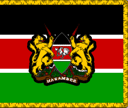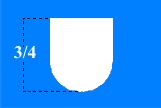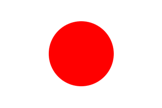
This page is part of © FOTW Flags Of The World website
Dictionary of Vexillology: H (Head - Hissflagge)
Last modified: 2014-11-14 by rob raeside
Keywords: vexillological terms |
Links: FOTW homepage |
search |
disclaimer and copyright |
write us |
mirrors
On this page:
HEAD
See ‘hoist 1)’ (also
‘heading’ and
‘masthead’).
HEAD, FLAGSTAFF
The topmost point of a flagstaff from which a flag can be flown, and which lies below the cap or finial
- see ‘finial’.
HEADING (or HEADER)
A piece of heavy material, usually canvas or double-ply bunting, along the
hoist edge of a flag, into which a rope is sewn as the hoistline, or into
which grommets are inserted to facilitate the hoisting of a flag - a hoist strip (see also
‘sleeve 2)’, ‘hoistline’, ‘grommet 1)’ and ‘hoist 1)’).

Please note that the increasingly (but by no means entirely) obsolete practice of fixing a flag to
its pole or staff by a series of attached loops is almost certainly based on the earlier use of ties –
see ‘loops’ (also ‘ring 4)’ and ‘ties’).
HEADQUARTERS FLAG
1) See ‘camp flag’.
2) In US military, naval and some other usage, the rank flag of a commanding officer when flown
from their headquarters ashore – a designating (of headquarters) flag (see also
‘rank flag 1)’ and
‘flag of command’).


Camp/Headquarters Flag, Training and Development Branch, Canada (fotw);
Rank/Headquarters Flag, Vice Admiral USN (fotw)
HEADSTICK
In largely naval usage a short piece of wood sewn into the top of a flag’s heading to allow the Inglefield
clip to be attached about five cm from the top, thus permitting the flag to be
hoisted right up to the truck, while enabling the top hoist corner of the flag to
remain straight and upright – but see ‘frame 2)’
(also ‘Appendix I’,
‘Inglefield clip’ and
‘truck’).

HEAD OF STATE'S COLOUR (or COLOR)
A King’s, Queen’s or Presidential Colour – see ‘colour 2)’ and ‘colours 2)’.


Presidential Colour of Kenya (fotw); Queen’s Colour of
Princess Patricia's Canadian Light Infantry (fotw)
HEAD OF STATE'S STANDARD (or FLAG)
A Royal, Imperial or Presidential standard – see
‘royal standard 1)’,
‘imperial standard 1)’ and
‘presidential standard’.



Royal Standard of The Netherlands (fotw); Imperial Standard of
Germany 1871 – 1918 (fotw); Presidential Flag of
Czechoslovakia 1920 – 1960 (fotw
HEIGHT
1) The vertical measurement of an emblem, shield, charge or badge when detailing the dimensions
- but see ‘width 3)’ (also
‘dimensions’ and
‘width across’)
2) see ‘width 1)’

HELM (or HELMET)
The metal headpiece from a suit of armour usually ensigned above the shield in a coat
of arms or set of armorial bearings, but sometimes seen as a separate charge (see also
‘Appendix IV’,
‘armorial bearings’,
‘coat of arms’,
‘crest 1)’,
‘ensigned’,
‘shield’ and
‘wreath 2)’).
Please note that in English heraldry the style and positioning
of a helm varies according to the rank of the bearer, and it is suggested that
a suitable glossary or dictionary of heraldry be consulted for full details.





Arms of Sir Winston Churchill (Official Website); Flag and arms of Josipdol,
Croatia (fotw and CS); Flag of Ozerna, Ukraine (fotw); Flag of Hejtmánkovice, Czech Republic (fotw)
HERALDIC BANNER
A banner of arms - see ‘banner of arms’
(also ‘armorial banner 2)’).
![[Banner of Kyiv]](../images/v/vxt-d005.gif)
![[Arms of Kyiv]](../images/v/vxt-d005a.gif)
Heraldic Banner and Arms of Kyiv, Ukraine (fotw)
HERALDIC BEASTS
The animals, birds and mythological creatures used as supporters and/or charges in a
set of armorial bearings, or on a banner of arms or a flag - but see note below (also
'armorial bearings', ‘banner of arms’,
‘griffin’,
‘phoenix’and
'supporters').
![[Banner of arms of Baltzers, LI]](../images/v/vxt-d1551.gif)
![[Udbina]](../images/v/vxt-d2175a.gif)
![[Udbina]](../images/v/vxt-d2175.gif)
![[DGF 21, Germany ]](../images/v/vxt-d2316.gif)
![[Lithuania president]](../images/v/vxt-d1615.gif)
Banner of Arms of Balzers, Liechtenstein (fotw);
Arms and Flag of Udbina, Croatia (fotw);
Flag of DGF 21, Germany (Klaus-Michael Schneider);
Presidential Flag of Lithuania (fotw)
Please note that it is beyond the scope of this
work to list all the animals traditionally used in heraldry, and for these a suitable
glossary or heraldic dictionary should be consulted, however, the basic attitudes
in which all such animals may be found (or presented) on a shield or banner of
arms are listed in Appendix V.
HERALDIC BADGE
See ‘badge in heraldry’ under ‘badge’.
![[heraldic badge]](../images/v/vxt-d2237.gif)
Badge of the Royal House of Tudor 1486 – 1603, England (wiki)
HERALDIC LILY
See ‘fleur-de-lis’.
![[Flag of Mesen, Belgium]](../images/v/vxt-d007.gif)
Flag of Mesen, Belgium (fotw)
HERALDIC STANDARD
See ‘standard 3)’ and
‘standard 4)’.
![[Heraldic standard example]](../images/v/vxt-d169.gif)
Heraldic standard of the Master Gunner St James’
Park UK (Graham Bartram)
HERALDRY
The science concerned with the designing, interpretation, recording and blazoning of
those armorial bearings and/or heraldic insignia that pertain to an individual, an
institution or to a corporate entity (see also
‘anti-heraldry’,
‘armorial bearings’,
‘blazon’,
‘coat of arms 2)’,
‘insignia’
and ‘pre-heraldic’).
HILTED (or HILT)
The heraldic term used when the grip, pommel and cross/hand guard of a sword or dagger are of a different
tincture to its blade – but see note below and ‘hafted’ (also
‘barbed’,
‘garnished’,
‘pommeled’,
‘shafted’ and
‘tincture’).





Flag of Karelia, Finland (fotw); Arms and Flag of
Barilovic, Croatia (fotw); Arms and Flag of
Fabianki, Poland (fotw)
Please note that heraldic writers will sometimes blazon the hilt and the pommel
(of a sword or dagger) separately when describing the charges on a coat of arms – hilted and pommeled.

(Parker)
HINOMARU (or HI-NO-MARU)
Literally “sun-disk” and the civil ensign/national flag of Japan
since 1870 (see also
‘daimyo flags’
‘disc’,
and ‘mon’).

National Flag of Japan (fotw)
Please note that, whilst acting in that role for many years, the Hinomaru was only formally adopted as the National Flag in 1999.
HIS MAJESTY’S JACK
In English RN usage now obsolete, an official term for the 1606 pattern union flag when
flown as a naval jack, and in use from c1640 – c1690 – the king’s jack or the jack – but see
‘British flag’ (also
‘interlaced’,
‘naval jack’ under ‘jack’,
‘James Union’ and
‘union jack 2)’).

Union Flag 1601 - 1801, UK (CS)
HISSFLAGGE (or HISSFAHNE)
See ‘hoisted flag’.
Hissflagge and Banner of Albisheim, Germany (fotw)
Introduction | Table of Contents
| Index of Terms | Previous Page | Next Page













![[Banner of Kyiv]](../images/v/vxt-d005.gif)
![[Arms of Kyiv]](../images/v/vxt-d005a.gif)
![[Banner of arms of Baltzers, LI]](../images/v/vxt-d1551.gif)
![[Udbina]](../images/v/vxt-d2175a.gif)
![[Udbina]](../images/v/vxt-d2175.gif)
![[DGF 21, Germany ]](../images/v/vxt-d2316.gif)
![[Lithuania president]](../images/v/vxt-d1615.gif)
![[heraldic badge]](../images/v/vxt-d2237.gif)
![[Flag of Mesen, Belgium]](../images/v/vxt-d007.gif)
![[Heraldic standard example]](../images/v/vxt-d169.gif)







